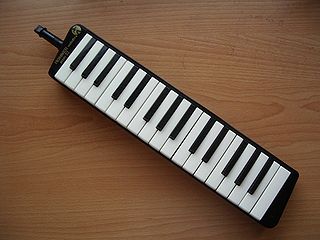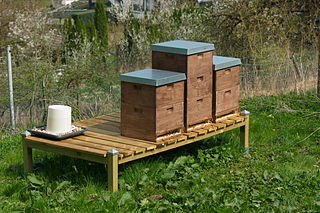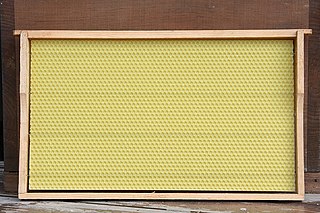Related Research Articles

An electric guitar is a guitar that requires external amplification in order to be heard at typical performance volumes, unlike a standard acoustic guitar It uses one or more pickups to convert the vibration of its strings into electrical signals, which ultimately are reproduced as sound by loudspeakers. The sound is sometimes shaped or electronically altered to achieve different timbres or tonal qualities on the amplifier settings or the knobs on the guitar from that of an acoustic guitar. Often, this is done through the use of effects such as reverb, distortion and "overdrive"; the latter is considered to be a key element of electric blues guitar music and rock guitar playing.

A drum machine is an electronic musical instrument that creates percussion sounds, drum beats, and patterns. Drum machines may imitate drum kits or other percussion instruments, or produce unique sounds, such as synthesized electronic tones. A drum machine often has pre-programmed beats and patterns for popular genres and styles, such as pop music, rock music, and dance music. Most modern drum machines made in the 2010s and 2020s also allow users to program their own rhythms and beats. Drum machines may create sounds using analog synthesis or play prerecorded samples.

The melodica is a handheld free-reed instrument similar to a pump organ or harmonica. It features a musical keyboard on top, and is played by blowing air through a mouthpiece that fits into a hole in the side of the instrument. The keyboard usually covers two or three octaves. Melodicas are small, lightweight, and portable, and many are designed for children to play. They are popular in music education programs, especially in Asia. The modern form of the instrument was invented by Hohner in the late 1950s, though similar instruments have been known in Italy since the 19th century.

An idiophone is any musical instrument that creates sound primarily by the vibration of the instrument itself, without the use of air flow, strings (chordophones), membranes (membranophones) or electricity (electrophones). It is the first of the four main divisions in the original Hornbostel–Sachs system of musical instrument classification. The early classification of Victor-Charles Mahillon called this group of instruments autophones. The most common are struck idiophones, or concussion idiophones, which are made to vibrate by being struck, either directly with a stick or hand or indirectly, with scraping or shaking motions. Various types of bells fall into both categories. A common plucked idiophone is the Jew's harp.

A beehive is an enclosed structure in which some honey bee species of the subgenus Apis live and raise their young. Though the word beehive is commonly used to describe the nest of any bee colony, scientific and professional literature distinguishes nest from hive. Nest is used to discuss colonies that house themselves in natural or artificial cavities or are hanging and exposed. Hive is used to describe an artificial/man-made structure to house a honey bee nest. Several species of Apis live in colonies, but for honey production the western honey bee and the eastern honey bee are the main species kept in hives.

An autoharp or chord zither is a string instrument belonging to the zither family. It uses a series of bars individually configured to mute all strings other than those needed for the intended chord. The term autoharp was once a trademark of the Oscar Schmidt company, but has become a generic designation for all such instruments, regardless of manufacturer.

The duduk or tsiranapogh, is an ancient Armenian double reed woodwind instrument made of apricot wood. It is indigenous to Armenia. Variations of the Armenian duduk appear throughout the Caucasus and the Middle East, including Azerbaijan, Georgia, Russia, Turkey, and Iran. Duduk, Balaban, and Mey are almost identical, except for historical and geographical differences.

In modern American beekeeping, a Langstroth hive is any vertically modular beehive that has the key features of vertically hung frames, a bottom board with entrance for the bees, boxes containing frames for brood and honey and an inner cover and top cap to provide weather protection. In a Langstroth hive, the bees build honeycomb into frames, which can be moved with ease. The frames are designed to prevent bees from attaching honeycombs where they would either connect adjacent frames, or connect frames to the walls of the hive. The movable frames allow the beekeeper to manage the bees in a way which was formerly impossible.

A hive frame or honey frame is a structural element in a beehive that holds the honeycomb or brood comb within the hive enclosure or box. The hive frame is a key part of the modern movable-comb hive. It can be removed in order to inspect the bees for disease or to extract the excess honey.

A honey super is a part of a commercial or other managed beehive that is used to collect honey. The most common variety is the "Illinois" or "medium" super with a depth of 65⁄8 inches, in the length and width dimensions of a Langstroth hive.
Steinberger is a series of distinctive electric guitars and bass guitars, designed and originally manufactured by Ned Steinberger. The name "Steinberger" can be used to refer to either the instruments themselves or the company that originally produced them. Although the name has been applied to a variety of instruments, it is primarily associated with a minimalist "headless" design of electric basses and guitars.
A waterphone is a type of inharmonic acoustic tuned idiophone consisting of a stainless steel resonator bowl or pan with a cylindrical neck and bronze rods of different lengths and diameters around the rim of the bowl. The resonator may contain a small amount of water giving the waterphone a vibrant ethereal sound that has appeared in movie soundtracks, record albums, and live performances. The instrument was invented, developed and manufactured by American Richard Waters (1935-2013).

Johann Dzierzon, or Jan Dzierżon or Dzierżoń, also John Dzierzon, was a Polish apiarist who discovered the phenomenon of parthenogenesis in bees.

Edward Weston was an English-born American chemist and engineer noted for his achievements in electroplating and his development of the electrochemical cell, named the Weston cell, for the voltage standard. Weston was a competitor of Thomas Edison in the early days of electricity generation and distribution.

The ANS synthesizer is a photoelectronic musical instrument created by Russian engineer Evgeny Murzin from 1937 to 1957. The technological basis of his invention was the method of graphical sound recording used in cinematography, which made it possible to obtain a visible image of a sound wave, as well as to realize the opposite goal—synthesizing a sound from an artificially drawn sound spectrogram.
The octavin is a woodwind instrument with a conical bore and a single reed. As such, it resembles a saxophone, and its range is similar to that of a soprano saxophone, but the octavin differs in three respects. First, its conical bore has a smaller taper than that of a saxophone; second, its body is made of wood, rather than metal; third, its usual shape is similar to that of a bassoon, having two parallel straight sections joined at the bottom, with the mouthpiece attached to the top of one section and a metal bell to the top of the other (a few straight octavins exist, having a wooden bell; in this configuration it resembles a tarogato but has a smaller taper). The instrument was produced in B♭ and C. One writer (Altenberg) mentions a bass octavin but no such instrument is known to have been produced. The (written) range of the octavin is from G♯3 to G6.

A bee smoker is a device used in beekeeping to calm honey bees. It is designed to generate smoke from the smoldering of various fuels, hence the name. It is commonly designed as a stainless steel cylinder with a lid that narrows to a gap with a half inch diameter. The base of the cylinder has another small opening that is adjacent to a bellow nozzle. Pumping of the bellows forces air through the bottom opening. The cylinder also commonly has a wire frame around it acting as a structure the user can grab without risk of burning their hand. Some smokers have a hook on the side allowing the user to hang the whole instrument on the side of a hive for easy access during an inspection or attach it to an ALICE belt when not in use.

A phonocardiogram is a plot of high-fidelity recording of the sounds and murmurs made by the heart with the help of the machine called the phonocardiograph; thus, phonocardiography is the recording of all the sounds made by the heart during a cardiac cycle.
Beekeeping in the United Kingdom is the maintenance of bee colonies by humans within the United Kingdom. It is a significant commercial activity that provides those involved with honey, beeswax, royal jelly, queen bees, propolis, flower pollen and bee pollen. Honeybees also provide pollination services to orchards and a variety of seed crops.

Wax foundation or honeycomb base is a plate made of wax forming the base of one honeycomb. It is used in beekeeping to give the bees a foundation on which they can build the honeycomb. Wax foundation is considered one of the most important inventions in modern beekeeping.
References
- 1 2 Boys, T.R. "Apidictor". Beesource.com. Archived from the original on 2005-07-17.
- ↑ Preston, Claire (2006). Bee. London: Reaktion Books. pp. 111–112. ISBN 9781861892560.
- ↑ USpatent 2806082A,Edward Farrington Woods,"Means for detecting and indicating the activities of bees and conditions in beehives",published 1957-09-10,issued 1957-09-10